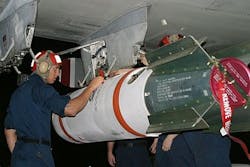Officials of the Naval Surface Warfare Center Panama City Division in Panama City, Fla., announced a $17.2 million contract to Sechan Monday to develop and build the Target Detecting Device (TDD) MK 71 Mod 1 to support the Quickstrike Mine Improvement program.
The TDD contains a multi-sensor suite with digital circuitry that uses a Navy-supplied target-detection algorithm to determine a firing solution for the Navy's Mk 65 purpose-built underwater mine, as well as for the Mk 63 and Mk 62 general-purpose bombs that converted to function as bottom mines.
The TDD algorithm determines whether or not a valid target enemy ship or submarine is present by processing sensor input data based on timing, period, and amplitude. When the system detects a target, the algorithm issues a command to detonate the mine.
Navy ordnance experts lay minefields using the Mk 65, Mk 63, and Mk 62 by dropping the mines from aircraft such as the B-52H Stratofortress, F/A-18A/D Hornet, B-1B Lancer, and P-3C Orion. Parachutes can deploy on the mines to slow them before entering the water.
The Mk 65 mine is a dedicated thin-wall 2,300-pound mine, while the Mk 63 is a 1,000-pound mine and the Mk 62 is a 500-pound mine. The Mk 63 and Mk 62 are converted from conventional aircraft bombs, which eases logistics aboard deployed Navy aircraft carriers. All three mines are in the Navy Quickstrike mine family.
The Mk 65 is the centerpiece of the Navy's Quickstrike family of mines. It uses variable influence-type target-detector systems against submarines and surface vessels. It has a special arming device, a nose fairing, and a tail section adaptable to parachute option.
The Mk 65 is 10.7 feet long, 2.4 feet in diameter, can operate in waters as deep as 600 feet, and packs variable explosive warheads as large as 2,000 pounds. The first versions of the Mk 65 were deployed with the Navy in 1983.
The Sechan TDD will control the actuation of explosives in Quickstrike underwater mines. Sechan experts will concentrate on three major areas of TDD development: target influence sensors; sensor signal processing and target logic; and timing and control logic.
These areas control the mine's trajectory, arming, and end-of-life functions. Sechan experts will work on advanced signal processing techniques applied to sensor outputs to determine if a valid target is present, or if the detected influence signal is being generated by a countermeasure device.
Sechan also will apply state-of-the-art, low power, microprocessor and field-programmable gate array (FPGA) technologies to the TDD for mine timing and control functions. Sechan will do the work on the current contract in Lititz, Pa., and should be finished by December 2018.
For more information contact Sechan Electronics online at www.sechan.com, or the Naval Surface Warfare Center Panama City Division at www.navsea.navy.mil/nswc/panamacity.



